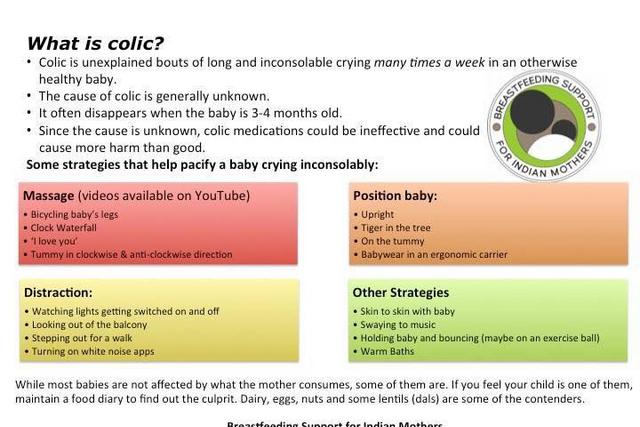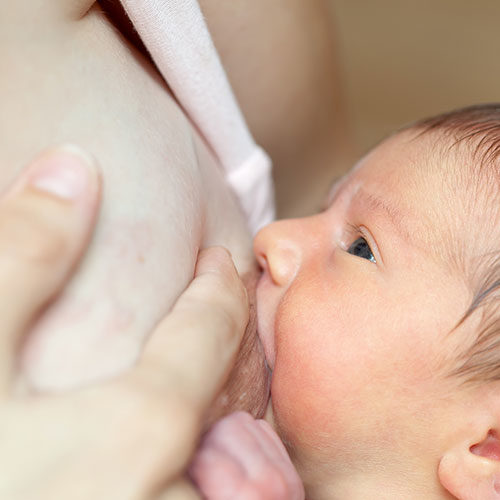Why is my baby always cranky? Why does my baby seem to be wanting to nurse while in pain? What exactly is Colic?
Colic is defined as inexplicable bouts of inconsolable crying in babies less than 3 months old. For a baby to be diagnosed as colicky, her crying outbursts need to last for at least 3 hours, 3 days a week and for 3 weeks at a stretch. In most cases, the diagnosis takes place before the baby has been observed for the above mentioned time frame, making colic an overused diagnosis in case of many babies. Another important thing to remember while making the diagnosis is that the baby should be otherwise healthy and gaining weight.
It is very difficult for parents to see their baby cry for an unfathomable reason and when almost every attempt to comfort the baby fails. A lot of times though, certain strategies might work temporarily. E.g. Rocking the baby, Walking with the baby, Baby-wearing etc. But these techniques often fail as well.
Reasons and Treatment for Colic:
The reasons for colic are unknown. It is true. We don’t yet know the reasons for colic in babies. Which is why, there is no proven treatment or cure for colic either. However, many medication and behavioural strategies are suggested that may or may not work on different babies at random.
Colic in Breastfed babies:
Usually, gassiness is less among breastfed babies as when a baby directly latches onto the breast, a vacuum is created which prevents any air to be swallowed by the baby while nursing as opposed to while drinking EBM or Formula milk from a bottle. But there are some situations in which breastfed babies may develop colic like symptoms.
- Poor latch If the attachment or latch is poor or shallow, the baby is unable to drink milk efficiently and also ends up swallowing a lot of air while nursing. This can manifest colic-like symptoms of gassiness and fussiness in the baby. Sometimes a poor latch may also be because of conditions like tongue ties. It is important to rule out these arriving at a diagnosis of colic.
- Overactive/fast letdown and oversupply When the mother has an oversupply of breast milk, it is usually accompanied by a fast or overactive letdown reflex. And when too much milk comes out at once, the baby becomes very fussy and irritable at the breast. There may be a lot of crying and rejection of the breast which leads to further fussiness and the whole situation turns into a cycle that’s difficult to break away from. Such babies too are sometimes called colicky. Addressing the oversupply and managing the fast letdown with strategies that involve different positioning etc can actually solve the problem to a great extent.
- Nursing with only one breast at each feeding / Nursing with both breasts at each feeding Both the above-mentioned scenarios are two extreme ends of a continuum. When the baby is nursed on only one side, the baby might get fussy because of hunger. Whereas when the baby is nursed on both the breasts each time, it might result in the baby taking too much foremilk (low in fat, but rich with sugar) therefore unable to satisfy her hunger leading to nursing more frequently, each time getting less fat yet high sugar. The digestive system struggles with handling so much sugar at a time and the baby suffers symptoms like explosive, watery, green poops in addition to being gassy and fussy. The ideal way to nurse a baby is striking the balance between foremilk and hindmilk consumption. The most effective way to go about it is to let the baby nurse from one breast and drain it. Then offer the other breast and let the baby nurse if and as much as she wants to. In the next nursing session, offer the second breast first and repeat the process.
Some other situations that bring about colic-like symptoms in babies are – reflux, allergies (to some particular food the mother might be consuming) and some culture-induced practices like limiting feeds, sleep training, separation from the mother on a regular basis etc.
Strategies to comfort a well-fed, yet inconsolable baby:
Most fussy babies are more settled when they are kept close to the mother. Skin to skin helps a lot. Also, tending to the baby before the baby becomes inconsolable is most effective. Giving unlimited access to breasts calms babies while trying out a variety of positions to see what is most preferred by the baby. Some more strategies are as follows.
- Holding the baby close. Carrying, walking, talking, singing to the baby etc help.
- Baby-wearing
- Keeping the baby in an upright position (burping)
- Warm water bath
- Gentle massage
- Colic hold (Magic baby hold) shown in the image –>
- Taking the baby to a quiet room
- Distracting the baby with other stimuli by taking the baby out
Once again, please remember that it is assumed that the baby is gaining weight well, is fed well and yet showing colic like symptoms. Never replace a nursing session by using any of the above strategies. Breastfeeding, more often than not, is a solution to most problems.
References:
https://www.canadianbreastfeedingfoundation.org/basics/colic.shtml
https://kellymom.com/mother2mother/m2m-fussiness/
https://kellymom.com/parenting/parenting-faq/gassybaby/
https://www.laleche.org.uk/i-think-my-babys-got-colic/
https://themilkmeg.com/does-my-baby-have-reflux-is-it-colic-why-is-my-baby-so-gassy-and-unsettled/


Image Courtesy: https://www.laleche.org.uk/i-think-my-babys-got-colic/
Wish to speak with a member of our team who is a certified lactation professional and also an experienced breastfeeding mother, click on this link.
Medical Advice Disclaimer
THIS WEBSITE DOES NOT PROVIDE MEDICAL ADVICE.
The information, including but not limited to, text, graphics, images and other material contained on this website are for informational purposes only. No material on this site is intended to be a substitute for professional medical advice, diagnosis or treatment. Always seek the advice of your physician or other qualified health care provider with any questions you may have regarding a medical condition or treatment before undertaking a new health care regimen, and never disregard professional medical advice or delay in seeking it because of something you have read on this website.
Disclaimer
We understand and acknowledge that parents and babies can be of various genders on a spectrum of LGBTQI+. Families come in diverse flavours. However, in our articles, for the sake of simplicity and convenience, we will be referring to the breastfeeding parent as the mother and using the female pronouns- ‘she’ and ‘her’ for babies. Babies can be nourished and nurtured in different ways and while we have used the terms breastfeeding and nursing, we recognize that parents can opt to chest feed or finger feed.
We don’t have conflicts of interest and declare, and we are compliant with the WHO code of marketing of breastmilk substitutes and the IMS act.
In case you find any information on this website that needs to be updated, please write to us at info@bsim.org.in






